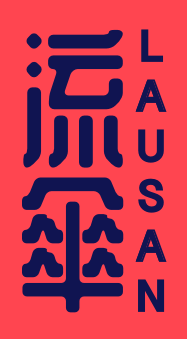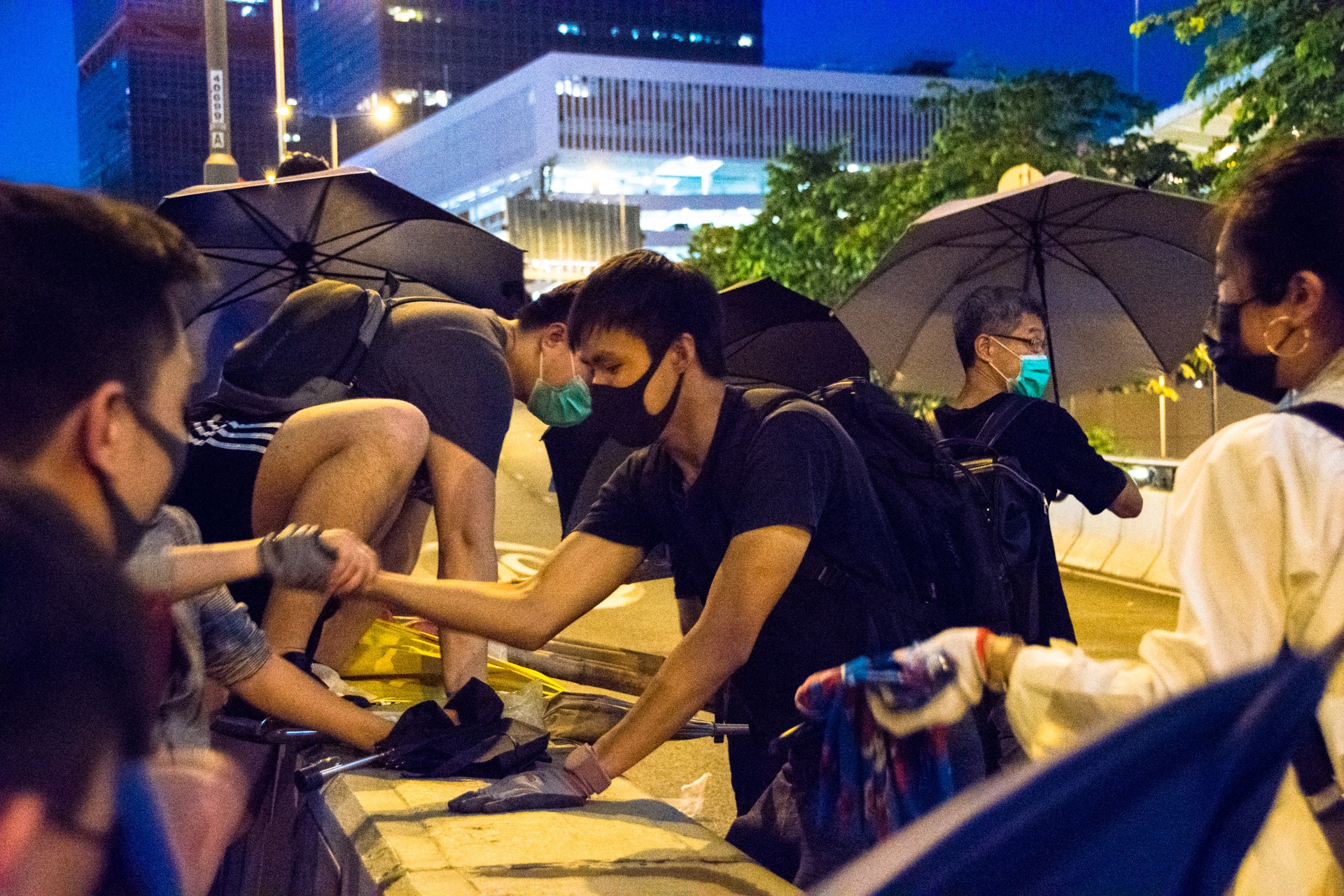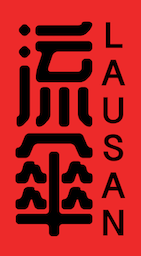Originally published on Good Men Project. Republished with permission. Read this article in Chinese and Bahasa Indonesia.
R. Benedito Ferrão is Assistant Professor of English and Asian & Pacific Islander American Studies at the College of William and Mary, and an internationally published writer.
In the many years I had come to the port city, I had never seen it like this. Hong Kong was in a state of siege. Arriving on August 5, the day of the General Strike, I was greeted by shuttered shops in Causeway Bay. It was 5PM. The city known for its commercial appeal and late nights wore a look of desolation. At Times Square, I saw clutches of black-clad young men and women, all with black masks on, some wearing hard hats, and others with black umbrellas unfurled as symbols of protest on the rainless day. I instinctively pulled out my phone for a picture.
One of the youths walked the few steps to where I was standing and asked if I could refrain from photographing protestors’ faces, his voice muffled by his mask. I showed him the picture I’d taken, umbrellas eclipsing everything but several pairs of legs in the waning light.
I had never seen Hong Kong like this.
The impetus for the protests had been the introduction, earlier this year, of a bill by Carrie Lam, Hong Kong’s Chief Executive, that would extradite criminal suspects to be tried in China. In September, Lam withdrew the bill. But the damage was done. The strengthened protest movement was calling for democratic reforms.
In 2014, the Umbrella Revolution had similarly demanded change, brollies again serving as symbols of protest. The movement was short-lived; this time, the umbrellas are yet to be put away as the protestors continue to question the relationship between Hong Kong and China, a matter that was never fully resolved at the end of British colonialism in the region.
Hong Kong was one of the first foreign cities I had traveled to on my own as an adult. I was 21 and journeying between California and my family in Goa on my first trip to see them after having immigrated to the United States.
My transit stop in Hong Kong will always hold a special place in my memory for this coming-of-age journey. But it was part of a larger moment in history. It was 1995, and in just over a year Hong Kong was to transition between the United Kingdom, which had held it for 99 years, and China.
A subsequent transit stop in Hong Kong allowed me to visit Macau. It was 1999, the year that Portugal’s lease on the island would terminate, causing Macau to also become part of China. The handover would close out a half-millennium of Portuguese colonialism in Asia, a sweep that extended to my own homeland. Goa, of the Estado da Índia, was held by the Portuguese between 1510 and 1961.
I hadn’t been the first person in my family to visit these last vestiges of European empires in Asian lands. Yet, prior to the visits of members of my family to these locales, the influence of the islands’ cultures had long been a part of our lives.
For me, Hong Kong and Macau have always seemed historically akin to Goa.
On his own visit to Hong Kong and Macau a few years ahead of me, my father had taken photographs of blue and white porcelain which were reminiscent of the bits of crockery that still remain in my grandparents’ home as in other Goan households.
The Lusophone world had connected various parts of Asia, such as Goa, Timor, and Macau, though some other intra-Asian connections even predated the arrival of the Portuguese in any of these places.
On my first trips to Hong Kong and Macau, I was given the phone numbers of Goan friends of the family in each place. In the years to come, I would learn of iconic figures whose familial histories bore evidence of the cultural and sanguine ties between these lands, among them the recently deceased China Machado. Born in 1929, Machado was one of the first models of color to achieve international fame, her lineage jointly Chinese, Goan, and Portuguese.
Given these connections, for me, Hong Kong and Macau have always seemed historically akin to Goa. Small places with complexly interwoven strands of diverse cultures, these enclaves imbibed and transmuted the influences that arrived from afar, localizing and making them their own. This is not to suggest that all was well in these colonial outposts.
Political resistance cropped up at many points in these lands’ histories. But such local lore, and the development of their own cultures, has been undermined in how the contemporary moment recounts the pasts of these territories, especially in the face of nationalism.
Unlike Hong Kong and Macau, the end of European rule in Goa didn’t come about as the result of an agreement. A two-day war concluded on December 19, 1961, when the Indian army quickly defeated the meagre Portuguese military force in Goa. While there had been various permutations of Goan political thought on the matter of colonialism, including pro-and anti-Portuguese and Indian factions, ultimately Goans were not given a choice in the matter of the independence of their own land.
The Indian annexation of Goa curtailed its people’s self-emancipatory efforts and made of the formerly Portuguese Indian territory a colony of a postcolony. The irony is palpable given that it had only been in 1947 that India had ousted its own British colonizers through self-determination.
As the week of my visit this August wore on in Hong Kong, things remained tense. Between the leftover signs in train subways from previous protests and the groupings of activists during a mid-week strike, it became clear that the movement wasn’t without its divisions. Despite the singularity of purpose of the protests, which was to challenge China’s hold on the island, there were such peculiarities as the presence of American flags.
Ultimately Goans were not given a choice in the matter of the independence of their own land.
This symbolic equivalence between the United States and democracy gives one pause, especially in light of the current revelations surrounding President Trump’s phone call to the Ukraine. Further, there have been attacks against protestors, demonstrating that not everyone on the island is of the same mind.
As I watched history unfold in Hong Kong, I felt I was being given a glimpse into what things might have been like when Goans worked out their own questions about colonialism in the first half of the twentieth century, even when there were groups at odds with one another.
I was in awe of the sheer feat of organization the youth on Hong Kong’s streets had pulled off in amassing the presence of so many in different parts of the city.
In their day, how had Goans spread word about secret meetings as well as public actions? Questions such as these are left generally unanswered in textbooks of history read by students in Goa today, the focus of the subject being the inculcation of a monolithic national heritage, and one with a right-wing bent.
On August 12, which was to be my final day in the city, a massive protest erupted, its execution an act of political genius. Protestors had taken over the airport to attract international attention.
When I attempted to catch the express train out of Hong Kong Station, black-clad protestors urged me and other travelers to turn back. As one of them explained to me, she didn’t want me to have any trouble at the airport. I was rather moved, thinking that this young woman could be no older than any one of my college students—the same age I was when I first came to this city.
I had tried calling my carrier, but the lines were tied up. The airline’s website still showed that my flight was on time. The short train ride to Hong Kong International Airport brought me face-to-face with an army of peaceful protestors who had escalated their efforts after a woman had lost an eye following a clash between the police and strikers.
The day before, police had shot beanbags at protestors in Tsim Sha Tsui, and one of these had hit the young woman in the face, blinding her. Amidst the sea of protestors and hapless travelers, no representatives were to be found for any of the airlines. There were going to be no planes leaving Hong Kong that evening.
I felt I was being given a glimpse into what things might have been like when Goans worked out their own questions about colonialism.
I decamped from the airport and made my way to a friend’s place. It wouldn’t be till the next day that I heard from the airline about new travel arrangements. Returning to the airport, I again saw protestors everywhere. I thought I might for a second day be unable to leave for Goa.
As with the first trip I had made to Hong Kong, I was once more traveling between two former European colonies which, at different points in their histories, had shared the fate of their political destinies being charted by people not of their own lands. Amidst the chaos, I made it out of Hong Kong and learned upon touching down that flights scheduled after mine had been grounded.
Over the past three decades, I have been in Hong Kong at three important junctures in its contemporary history: pre- and post-handover and, now, during this new revolution. That the city’s youth are at the forefront of this moment is striking. There are parallels to be made with other instances of political action in history where young people have led the charge, including the Civil Rights era of the 1950s and 60s in the United States.
But it isn’t just the past from which one may draw examples of youth leadership, what with the attention young leaders have brought to that most pressing concern of our time: climate change.
Even so, the youth-led revolution in Hong Kong is revelatory of more than its own impact. As I have been musing, it also harkens back to Goa’s struggles with coloniality. If this moment in Hong Kong is an aperture through which to see the past, what the protests may lead us to see is that there are other places in the world where political action is ongoing but not as visible.
In July this year, I visited Hebron in Palestine and learned of the work of a non-violent group called Youth Against Settlements who have been struggling against the incursions of Israeli settlements in their hometown. Closer to Goa, on August 5—the day I arrived in Hong Kong—India abrogated the special status of the disputed region of Kashmir, thereby removing any veneer of democracy the country might have heretofore displayed in its dealings with the region. As in Palestine, Kashmiri activists continue to rail against the violation of their rights, even as the international community looks the other way.
Akin to these other parts of the world, what we see in Hong Kong are the issues that have lingered on from the colonial past and the rise of postcolonial nationalism. What we are also bearing witness to is a period of uncertainty for Hong Kong’s future.
Between history and what is to come, Hong Kong harbors in this current moment a profound time of change. In this demonstration of the power of protest, Hong Kongers validate the ability of minorities to speak out in determining the destinies of their own land and, in so doing, remind us that similar struggles exist elsewhere.





